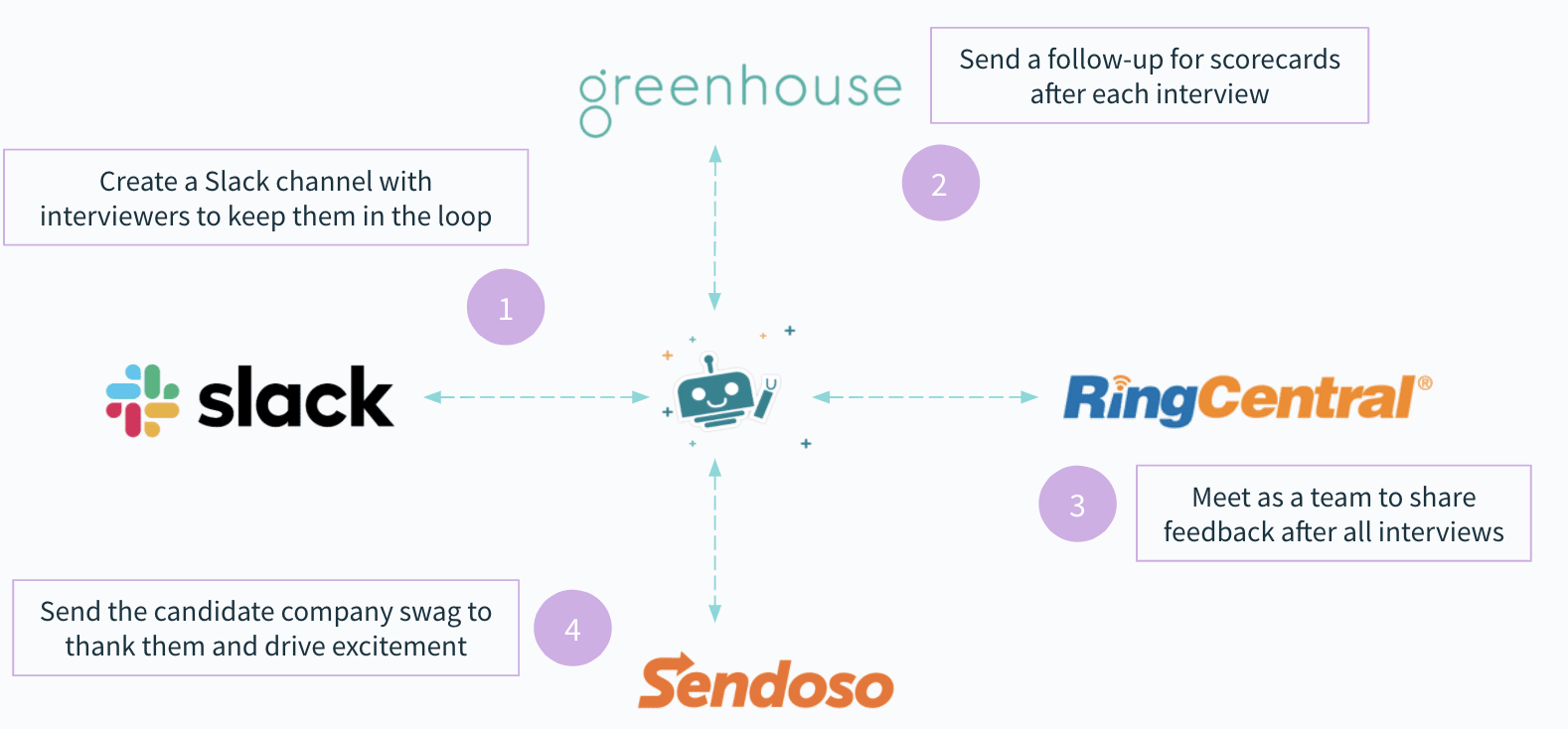Any company with lofty goals needs a world-class team that can execute them.
Did you set an aggressive quota? You’ll need a stellar ensemble of sales reps who can meet it. Is your product roadmap ambitious? You’ll need best-in-class engineers and product managers who can deliver. And are you looking to improve your customer retention rate? You’ll need customer success managers who can rise up to the challenge.
At the very core of building this well-rounded, best-in-class team is recruitment.
This begs the question: How can your organization recruit the best talent, quickly? And how can you do so in a way that benefits your interviewers, hiring managers, candidates, and the organization more broadly?
The answer to both questions is automating your recruitment process.
We’ll break down everything you need to know about this type of workflow automation. This includes how, exactly, it can work across various recruitment workflows, and the top benefits that individuals and the organization at large can expect to gain.
But to start, let’s align on its definition.
What is recruitment automation?
Recruitment automation is the use of automation to streamline a recruitment workflow. This requires a platform that can “listen” to your apps for business events and, when a certain condition is met, trigger real-time actions across your apps.
This type of HR automation can apply to any part of the recruitment process. This means it can help you with anything from keeping job descriptions current, to analyzing resumes, to managing candidate interviews, to creating offer letters. And while there isn’t necessarily one form of workflow automation that you should favor over another, it’s generally the case that the more recruitment automations you implement, the more your candidates, interviewers, and your business as a whole benefits.
How to streamline recruitment operations
With this definition in mind, let’s cover a couple of common recruitment automation use cases:
1. Streamline virtual candidate interviews
As most of us now interview candidates remotely, we’ve come across new challenges: Interviewers can easily hop onto an interview at an inappropriate time; candidates can find themselves waiting around while an interviewer searches for the instructions in joining the call; an interviewer or candidate has poor internet reception—and so on and so forth.
While it isn’t bulletproof, you can help interviewers coordinate with one another and run their interviews successfully by adopting the following workflow automation:

- Once the date for the candidate interview is scheduled, the workflow gets triggered.
An enterprise chatbot (like Workbot) creates a Slack channel for all of the interviewers. Within the channel, each interviewer can find the time they’re slated to speak with the candidate, the RingCentral link they can use to join the interview, and additional links where they can access information on the interviewer. The latter includes the items the candidate submitted as part of their application, such as their resume and cover letter.
Once the first interview is five minutes away, the enterprise chatbot notifies the group via Slack. And as the candidate officially begins their interview, the interviewers are kept in the loop. For example, once an interviewer finishes speaking to the candidate, the enterprise chatbot notifies the next interviewer that it’s their turn.
- As each interviewer finishes speaking to the candidate, the chatbot messages them a link to their scorecard (which can come from an applicant tracking system, like Greenhouse). This all but ensures that they provide timely feedback and do so while it’s top of mind.
- Once all of the interviewers finish, the chatbot messages the group a link to another meeting, where they can discuss the candidate and decide whether to move them forward in the process.
- The candidate receives company swag (e.g. company-branded t-shirt) via a platform like Sendoso a few days after their interview. This can help the candidate feel appreciated by the prospective employer and it can help the company stand out, assuming the candidate ends up evaluating multiple organizations.
2. Fuel employee referrals
After years of experience, your colleagues have likely amassed a wide network of highly-talented professionals who could be valuable members of your team. An international study that surveyed thousands of corporate talent acquisition leaders only validates this: Organizations cite employee referrals as the best channel for sourcing quality candidates.
You can encourage your colleagues to tap into their networks and refer former co-workers, friends, family, etc. for open positions by adopting the following workflow automation:
- When an employee selects the option of referring a candidate within a platform like Slack, the workflow gets triggered.
- Within the business communications platform, the enterprise chatbot asks the employee for high-level info on the referral. This can include the candidate’s full name, their phone number, the role they’re being referred for, a link to their Linkedin profile, etc.
- Once submitted, the referral, and the information that was included, is automatically added to your applicant tracking system, where your recruiter can find the prospective employee and kickstart the interview cycle. It’s worth noting that the enterprise chatbot can also message the appropriate hiring manager about the referral via your business communications platform.
3. Fast-track the process of distributing offer letters to approved candidates
Once interviewers finally agree on the candidate they’d like to bring on board, you can turn to workflow automation to move quickly in getting the offer approved by the appropriate stakeholders, creating the offer letter, and sending it off for signatures.
Here’s more on how the workflow can work:

- Once a candidate moves to the offer stage in a platform like Greenhouse, the workflow gets triggered.
- A chatbot pulls the offer details from Greenhouse and shares them with the appropriate internal stakeholders via a platform like Slack.
- The employees can decide whether to accept or reject the terms of the offer within the business communications platform.
- Assuming everyone approves the offer, it gets created on a platform like Docusign.
- The hiring manager can give the offer letter one final review and then send it off to the candidate for signature.
- After the candidate signs the document, their status in Greenhouse changes and the offer letter itself may even be uploaded to the platform.
Why is recruitment automation important?
With these use cases in mind, let’s explore some of the top benefits of recruitment automation.
1. It saves interviewers time
The interview cycle can be extremely time consuming when done manually. It requires your team to constantly hop between apps in order to upload documents, change statuses, add notes, etc.
At the same time, it requires a significant amount of coordination across your team. Your hiring manager may need to do any of the following:
- Resend resumes to interviewers
- Ask interviewers to complete their scorecards
- Schedule meetings across interviewers to discuss candidates
- Remind colleagues to review and approve the terms of their offer letter
- Work with procurement in acquiring swag for candidates
These coordination efforts may not seem like all that much work, but when you consider the fact that your team is likely evaluating several candidates for the role (and there are many open roles across your organization), the level of manual effort involved quickly multiplies.
Recruitment automation can effectively eliminate these coordination-based tasks as well as all the app-hopping that’s required for updating internal systems. This not only results in significant time savings for your team, but it also enables them to enjoy their job all the more, as they can avoid a large chunk of this manual-intensive work and focus on more thoughtful, business-critical tasks, instead.
2. It accelerates your time-to-hire
According to research by Yello, the average time-to-hire is 3-4 weeks.
If you’re looking to attract world-class candidates, that time frame is far too lengthy. After all, your target candidates are likely interviewing at other companies, and if any employer bidding for their services happens to have a shorter interview cycle than yours, your organization is put at a disadvantage.
Recruitment automation allows you to streamline each stage of the candidate journey by removing most manual tasks—from scheduling interviews to creating offer letters. This, in turn, should save your team at least several days when recruiting target candidates.
3. It allows interviewers to evaluate candidates more critically
When interviewers have a hard time finding a candidate’s resume or they forget what the job description entails, they’re bound to ask candidates more mundane questions that do little in the way of helping them evaluate and compare prospective colleagues.
Using recruiting automation, your interviewers can access all of the resources they need before their interview, and do so in the business communications platform they’re already using (e.g. Slack). This can help motivate them to study up on candidates and come into each interview with thoughtful and insightful questions lined up.
4. It provides candidates with a high-quality experience
There’s no guarantee that you’ll recruit your top candidate successfully. But by using workflow automations to move candidates through the various stages of the interview cycle quickly, and by having employees come into each interview on time and prepared, you’ll be more likely to leave a positive impression on candidates.
In addition, you can build a workflow automation that continually provides real-time updates to the platform you use for posting jobs. This can help prevent candidates from applying to roles that have already been filled, and it allows them to fully understand what a job entails, should any changes get made to a role. In both cases, you’re saving your candidates time and removing potential confusion—which can all but ensure that they remain happy with your organization.
5. It improves the overall reputation of your organization
By providing candidates and employees with pleasant, frictionless experiences, you can convert at least some of them into advocates of your employer brand.
This can lead to all kinds of benefits to your business:
- Employees may be more inclined to stay at your organization while candidates may be more eager to join your organization
- Employees may leave more positive reviews on sites like Glassdoor, which can only help your recruitment efforts
- A candidate who doesn’t receive an offer may reapply to another open job position later on (which may be a better match for them)
- A candidate that chooses another employer may return if they don’t like their new role
- Employees or candidates may speak highly of your organization either in person or across social channels
The list goes on, but the point is clear: When your employees and candidates are happy, everybody wins.
Ready to automate your recruitment workflows? You can use Workato, the leader in integration-led automation, to power any.
To learn more about the platform and to discover how you can use it with RingCentral to fuel your recruitment efforts (in addition to other use cases), you can visit Workato’s profile in Ringcentral’s app gallery here.
Originally published Mar 03, 2021, updated Sep 23, 2021

